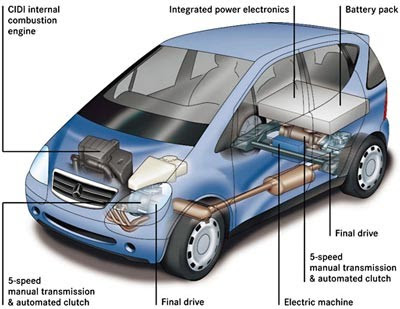Electricity has been used to power transportation vehicles since the early 1900s. When used to power electric vehicles (EVs), electricity is stored in an energy storage device such as a battery. EV batteries have a limited storage capacity and their electricity must be replenished by plugging the vehicle into an electrical source. The electricity for recharging the batteries usually comes from coal, but renewable sources such as solar, wind, or geothermal energy can also generate electricity. The range of electric vehicles is limited; thus, they are particularly well suited to short-distance, high-use applications -- they frequently are used inside airports, on college campuses, or in parks or recreation centers. For regular city and highway driving, electricity can work in conjunction with a gasoline-powered engine, as in hybrid vehicles. Fourteen hybrid car models are available for sale today. In total, almost 300,000 American drivers own hybrid cars. For a list of hybrid vehicle makes and models, visit Discover Alternatives.
Hybrid power generation: Hybrid-electric vehicles refer to powertrains that use a battery-powered electric motor, a gasoline internal combustion engine, and a concept known as regenerative braking to power the vehicle. To optimize performance, emissions, and fuel efficiency, a computer manages the energy from these three systems. The computer senses the driving mode and the battery state of charge and then directs energy from either the battery system or the gasoline engine to the most appropriate drive train component, an electric motor or an engine drive shaft. Regenerative braking systems, which recover energy that is otherwise wasted, allow hybrids to be especially fuel-efficient in stop-and-go city driving. Utilizing these hybrid technologies, fuel economy can be improved by up to 25 percent over conventional automobiles.
Hybrid power generation: Hybrid-electric vehicles refer to powertrains that use a battery-powered electric motor, a gasoline internal combustion engine, and a concept known as regenerative braking to power the vehicle. To optimize performance, emissions, and fuel efficiency, a computer manages the energy from these three systems. The computer senses the driving mode and the battery state of charge and then directs energy from either the battery system or the gasoline engine to the most appropriate drive train component, an electric motor or an engine drive shaft. Regenerative braking systems, which recover energy that is otherwise wasted, allow hybrids to be especially fuel-efficient in stop-and-go city driving. Utilizing these hybrid technologies, fuel economy can be improved by up to 25 percent over conventional automobiles.






No comments:
Post a Comment